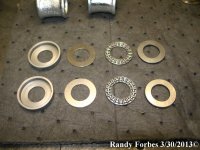RAC68
Darth Vader
Offline
Hi All,
Today, after changing the oil and filter, I reset the air pressure to 32lbs on the front and 28lbs on the rear as Glenon mentioned. This was after lowering the front end with 3/8" spacers (nuts). Took the Healey out for an enthusiastic ride through the hills and found the car to track and respond great on tight turns and on straightaways. The ambient temperature was quite chilly, around 40F but the Vredestein Sprint Classic 165HR15s held quite well on rough asphalt turns and seemed to settle in and need no constant corrections at highways speed.
Ray(64BJ8P1)
Today, after changing the oil and filter, I reset the air pressure to 32lbs on the front and 28lbs on the rear as Glenon mentioned. This was after lowering the front end with 3/8" spacers (nuts). Took the Healey out for an enthusiastic ride through the hills and found the car to track and respond great on tight turns and on straightaways. The ambient temperature was quite chilly, around 40F but the Vredestein Sprint Classic 165HR15s held quite well on rough asphalt turns and seemed to settle in and need no constant corrections at highways speed.
Ray(64BJ8P1)

 Hey there Guest!
Hey there Guest!
 smilie in place of the real @
smilie in place of the real @
 Pretty Please - add it to our Events forum(s) and add to the calendar! >>
Pretty Please - add it to our Events forum(s) and add to the calendar! >> 









 A friendly reminder - be careful what links you click on here. If a link is posted by someone you don't know, or the URL looks fishy, DON'T CLICK. Spammers sometimes post links that lead to sites that can infect your computer, so be mindful what you click.
A friendly reminder - be careful what links you click on here. If a link is posted by someone you don't know, or the URL looks fishy, DON'T CLICK. Spammers sometimes post links that lead to sites that can infect your computer, so be mindful what you click.